
Roots
When we consider the outermost layer of a textured hair strand, its delicate cuticle, we begin to grasp an ancient wisdom that speaks to resilience. For centuries, ancestral communities have held a profound understanding of how to safeguard this protective shield, passing down methods through generations. This knowledge, born from keen observation and a deep connection to the living world, offers more than mere hair care; it represents a legacy of adaptive ingenuity, a testament to the enduring spirit of Black and mixed-race peoples. What secrets do these time-honored practices hold for the health and preservation of our coils and kinks, whispers from a distant past that still sing in the present moment?

The Hair Strand’s Ancient Structure
A single strand of hair, though seemingly small, holds a universe of information within its form. From a biological standpoint, textured hair, like all human hair, possesses a cuticle. This external layer consists of overlapping cells, much like shingles on a roof, oriented towards the tip of the hair. In straight hair, these scales lie relatively flat.
With textured hair, particularly those with tighter coil patterns, the cuticle scales may lift more readily at the curves and bends, rendering the strand more susceptible to moisture loss and external stressors. This inherent structural characteristic, deeply rooted in our biological heritage, meant that early caretakers intuitively understood the necessity of sealing and smoothing this outer sheath. They recognized, long before microscopes were conceived, that a protected cuticle was a conduit to robust, vibrant hair.
For ancestral communities, understanding the hair’s very being stretched beyond the visible. They perceived hair not merely as a biological appendage, but as a living antenna, a connection to lineage, to spirit, and to the earth itself. This perception informed every choice, every ingredient, and every gesture in hair tending.
It speaks to a holistic approach where the health of the strand was inextricably linked to the wellbeing of the individual and their community. The preservation of the cuticle, therefore, wasn’t a superficial concern; it was a sacred duty, a tangible expression of reverence for one’s own inherited form.
Ancient care practices for textured hair honored the cuticle as a vital shield, preserving its integrity through generations.

Ancestral Views of Hair Anatomy
Across various African societies, hair was a profound marker, a canvas upon which identity, status, and even spiritual beliefs were inscribed. The nuances of hair preparation, from cleansing to adornment, stemmed from an inherited understanding of what the hair required to stay healthy in diverse climates. Consider the indigenous communities residing in arid regions, where sun and dry air were constant companions. Their practices often centered on enriching the hair with protective substances, substances that coated the hair shaft, effectively laying down those delicate cuticle scales.
These were not random acts; they were precise, often ritualistic applications grounded in centuries of observation of how natural elements interacted with their unique hair patterns. This profound wisdom, passed from elder to child, provided a foundational framework for safeguarding the hair’s outer layer, a framework that aligns strikingly with contemporary scientific understanding of cuticle protection.
The concept of hair’s “health” in these ancient contexts extended beyond superficial sheen. It encompassed pliability, elasticity, and the ability to retain length – all indicators of an intact cuticle. When the hair felt soft, when it resisted snagging, when it held its shape for elaborate stylings, it communicated care and proper attention.
These qualities, though described in pre-scientific terms, point directly to the benefits of a well-maintained cuticle. The natural oils, butters, and plant extracts employed served as early conditioners and sealants, their efficacy refined through countless generations of practical application.

Early Classifications and the Hair’s True State
While modern hair typing systems categorize textured hair into intricate numerical and alphabetical schemes, ancestral knowledge operated with a different lexicon. Hair might be described by its relationship to specific plants, animals, or even natural phenomena. A hair texture might be likened to the coils of a vine, the spring of a lamb’s wool, or the tightness of a freshly spun rope.
These descriptors, far from being imprecise, conveyed a deep experiential understanding of the hair’s inherent characteristics, including how its cuticle might behave. They recognized that some hair was inherently drier, more prone to frizz, or more likely to shrink, signaling a need for particular care strategies focused on moisture retention and external protection.
- Shea Butter ❉ From West Africa, prized for its ability to moisturize and serve as a base for hair treatments.
- Red Palm Oil ❉ From Central and West Africa, used for shine, moisture, and sun shield.
- Qasil Powder ❉ East African, utilized as a hair cleanser and conditioning aid.
- Baobab Oil ❉ Central and Southern African, valued for nourishment.
- Henna ❉ Ancient Egyptian and North African, for strengthening and tinting hair, also contributing to a stronger cuticle.
These traditional “classifications” were not about rigid categorization but about guiding practical application. If hair possessed a certain quality – say, a tendency towards extreme dryness – the inherited wisdom prescribed specific oils or butters known to “guard” that dryness, which we now understand as sealing the cuticle. This functional classification ensured that care was always tailored to the hair’s specific needs, long before scientific analysis could break down keratin bonds or measure trans-epidermal water loss. The very language used to describe hair’s varied forms was imbued with actionable wisdom.
| Aspect Hair's Outer Sheath |
| Ancestral Understanding A vital protective cover, easily lifted, requiring 'laying down' and sealing for strength and beauty. |
| Contemporary Scientific View The cuticle, composed of overlapping scales, lifts at curves, leading to moisture loss and vulnerability. |
| Aspect Moisture Retention |
| Ancestral Understanding Achieved through rich emollients and protective styles to prevent dryness and brittleness. |
| Contemporary Scientific View The cuticle's integrity directly affects the hair's ability to retain water; sealants reduce water sorption. |
| Aspect Environmental Shield |
| Ancestral Understanding Natural materials provide a physical barrier against sun, dust, and elements. |
| Contemporary Scientific View Oils form a film on the hair surface, providing a hydrophobic layer that guards against external aggressors. |
| Aspect The enduring wisdom of ancient practices consistently reveals a deep, intuitive grasp of hair's core protective requirements. |

The Hair’s Cycle and Environmental Dialogues
The cycles of hair growth and shedding were observed with an astute eye by ancestral communities. They understood that hair’s vulnerability shifted with its age and exposure. Hair that had endured seasons of sun, wind, and daily handling would naturally be more susceptible to damage. This informed practices of consistent renewal and reapplication of protective substances.
Think of the communal grooming rituals where elders applied nourishing preparations, working them into the hair from root to tip, especially concentrating on the older, more exposed ends. This continuous interaction was a recognition of the hair’s ongoing journey and its constant need for maintenance to keep its outermost layers guarded.
Environmental factors were not seen as separate challenges but as integral parts of the hair’s existence. The heat of the sun, the dryness of the air, the presence of dust – these were all elements that the hair encountered daily. Ancient solutions, therefore, were designed to interact directly with these forces. For instance, the use of various clays and plant powders, sometimes mixed with oils, could create a physical barrier against environmental particles while also delivering conditioning benefits.
The aim was to fortify the hair’s natural defenses, ensuring that the cuticle remained a smooth, impenetrable barrier, allowing the internal structures to thrive. This deep ecological awareness, passed through generations, shaped hair care into an ongoing conversation between the hair, the body, and the land itself.

Ritual
The preservation of textured hair cuticles through ancient knowledge extends beyond basic understanding; it materializes in the rich tapestry of ancestral styling techniques and the tools crafted with intentionality. These practices were not merely cosmetic endeavors. They were cultural statements, protective measures, and communal bonds, all of which played a part in safeguarding the hair’s external layer. How did these time-honored rituals, passed down through the generations, directly contribute to the integrity of the textured hair cuticle, offering protection and strength against the elements and everyday life?

Protective Styling’s Deep Lineage
Consider the myriad forms of protective styles that grace textured hair ❉ braids, twists, cornrows, and various forms of intricate coiling. These styles, found across the African continent and its diaspora, represent an ancient understanding of hair physics and longevity. By gathering sections of hair and securing them, these styles minimize direct exposure to environmental friction, physical manipulation, and the harshness of sun and wind. This reduction in external stressors directly translates to less mechanical damage on the cuticle.
When hair is left loose, each movement, each brush against fabric or skin, causes tiny abrasions and lifting of the cuticle scales. Protective styles, in essence, provide a sanctuary for the hair shaft, allowing the cuticle to remain undisturbed and intact for longer periods.
For example, in Chad, women employ a traditional method involving Chébé Powder, a specific blend of indigenous herbs. This powder is typically mixed with oils or butters and applied to the hair before braiding. This ancestral practice, observed across generations, is renowned for aiding length retention by effectively ‘filling hair shaft spaces and sealing the cuticle.’ The Chébé acts as a physical fortifier, creating a protective sheath around each strand.
When the hair is then braided, this botanical infusion is held close, allowing its beneficial properties to continuously interact with the hair, minimizing friction and keeping the delicate cuticle smooth and laid down. This synergy of natural ingredients and protective styling illustrates a sophisticated, heritage-driven approach to hair preservation.
The wisdom embedded in these styles extends to their preparation and dismantling. Hair was often conditioned with plant-derived emollients prior to braiding, ensuring pliability and reducing friction during the styling process itself. The untangling of these styles was also a slow, deliberate act, often accompanied by the application of more softening agents, minimizing breakage and cuticle disruption. This holistic approach, from preparation to maintenance, points to an inherited knowledge that understood the textured hair cuticle’s particular needs.

Traditional Methods of Defining and Holding
Defining and holding the natural coil patterns of textured hair was also a practice steeped in cuticle care. While modern products offer gels and creams for definition, ancestral communities relied on botanical extracts and plant mucilages. These natural substances, when applied to wet hair, would coat the strands, providing a gentle hold that helped maintain the hair’s natural curl pattern as it dried. This ‘setting’ of the hair prevented excessive unraveling and subsequent friction, thereby preserving the cuticle’s smooth surface.
- Oiling Rituals ❉ Applying specific oils (like coconut or red palm oil) to cleanse, protect, and seal the hair’s outer layer.
- Clay and Herb Packs ❉ Using natural clays and powdered herbs (such as Qasil or Chébé) as masks or washes for cleansing and strengthening.
- Butter Applications ❉ Massaging rich plant butters (like shea butter) into the hair for deep moisture and cuticle conditioning.
Moreover, the ritualistic application of these substances often involved massaging them into the hair and scalp. This not only promoted circulation but also helped to evenly distribute the protective layer across the hair shaft, ensuring comprehensive coverage of the cuticle. The warmth generated from this massage, coupled with the natural properties of the ingredients, could aid in temporarily softening the cuticle, allowing beneficial compounds to settle onto the strand before resealing.
Protective styling and careful product application in ancestral practices directly reduced cuticle friction, guarding hair.

Tools from the Ancestral Hair Kit
The implements used in ancient hair care were often as thoughtful as the practices themselves. Combs crafted from natural materials like wood, bone, or ivory were designed with wide teeth, minimizing snagging and breakage. These tools, often hand-carved and passed down, encouraged gentle detangling, a critical step in preserving the cuticle.
Rough manipulation or harsh brushes would strip the cuticle, leading to frizz and vulnerability. The smooth, polished surfaces of traditional combs allowed for careful separation of strands, respecting the hair’s coil pattern and its delicate outer sheath.
Beyond combs, specialized tools for braiding, twisting, or creating specific adornments also played a part. These tools facilitated the creation of structured styles that inherently protected the hair. For instance, the use of various threads in African hair threading, known as “Irun Kiko” among the Yoruba people, involved wrapping sections of hair to stretch and protect it from breakage. This technique, which secured the hair in three-dimensional corkscrew patterns, reduced exposure and thus cuticle damage.
The very design of these historical instruments supported the overarching goal ❉ to treat hair with respect, preserving its integrity and, by extension, the health of its cuticle. These instruments were not impersonal objects; they were extensions of caring hands, embodying centuries of skill and reverence for hair.
This heritage of careful tool selection highlights a deep understanding of textured hair’s mechanical properties. The awareness that forceful handling could lead to damage—damage that we now identify as cuticle abrasion—guided the creation and usage of every comb, pick, or styling aid. This meticulousness underscores the profound connection between cultural practice and the physical preservation of hair.

Relay
The echoes of ancient hair knowledge resonate through contemporary understandings of textured hair, illustrating how ancestral wisdom, far from being quaint folklore, holds profound scientific and cultural significance for guarding the hair cuticle. This enduring legacy speaks to an advanced comprehension, refined over millennia, that continues to shape modern holistic care and problem-solving for Black and mixed-race hair. How does the cumulative ancestral wisdom, particularly regarding the hair cuticle, provide a timeless blueprint for both daily regimen and addressing hair concerns within heritage contexts?

Building Regimens from Ancestral Blueprints
Modern personalized textured hair regimens, those truly effective ones, often mirror the principles established by ancient practices. The emphasis on moisturizing, sealing, and protective styling finds direct lineage in historical methods. For centuries, ancestral communities utilized a layered approach ❉ cleansing with gentle, natural agents (like certain clays or saponin-rich plants), then conditioning with rich butters and oils, and finally, protecting the hair through intentional styles. This layering strategy was, at its core, a sophisticated method of reinforcing the hair’s outer cuticle, ensuring its scales remained flat and sealed.
Consider the pervasive use of natural oils in African hair care, a practice that transcends individual cultures and spans millennia. Research confirms the efficacy of certain oils in protecting the hair. For instance, a 1999 study on the effect of oil treatments on hair protein to combat combing damage highlighted how Coconut Oil specifically reduced the tendency of the hair cuticle to swell, which in turn reduced protein loss.
This scientific validation illuminates the foresight of ancestors who consistently incorporated coconut oil and similar emollients into their hair care, intuitively understanding its protective qualities for the hair’s outermost layer. Such knowledge was not simply passed through oral tradition; it was enacted, lived, and refined across countless generations, proving its worth through observable results of strong, vibrant hair.
The selection of ingredients was equally deliberate. Ancestral communities did not use a random collection of plants. They utilized those that offered specific benefits, often identified through generations of empirical testing. Botanicals rich in fatty acids, like shea butter or red palm oil, would deposit a conditioning film on the hair, acting as physical barriers that would smooth down the cuticle.
Herbs with mucilaginous properties could provide slip for detangling, reducing mechanical friction that lifts cuticle scales. This deep understanding of natural chemistry, albeit unwritten in scientific journals, underpinned every aspect of their sophisticated regimens, all geared towards preserving the hair’s external defense.

Nighttime Practices and Bonnet Wisdom’s Deep Roots
The contemporary practice of covering textured hair at night with silk or satin bonnets, scarves, or pillowcases is a direct continuation of ancestral wisdom concerning cuticle preservation. This is far from a modern invention. Historically, various forms of head coverings were utilized across African cultures, not only for adornment or social messaging but also for practical protection.
During sleep, hair is prone to friction against rough surfaces, causing cuticle scales to lift, leading to tangles, frizz, and ultimately, breakage. The smooth, often naturally derived fabrics used historically minimized this friction.
These practices reflect an astute understanding of how to mitigate environmental stressors, even during periods of rest. The careful wrapping of hair, or the use of soft head coverings, created a micro-environment that preserved moisture and shielded the hair from the abrasive action of coarser sleeping surfaces. This protective measure was especially critical for textured hair, which, as studies show, struggles with moisture retention due to its unique coiled structure and the way natural oils traverse its length. The historical use of protective head coverings, therefore, was a proactive strategy to maintain cuticle integrity, a silent nightly ritual ensuring the longevity of each strand.
Ancestral nightly hair coverings offered proactive cuticle protection, safeguarding moisture and preventing friction during rest.

Ancient Remedies for Hair Challenges
Ancestral knowledge also possessed a sophisticated repertoire for addressing common hair challenges, many of which directly relate to cuticle health. Dryness, breakage, and scalp irritation, all symptomatic of a compromised cuticle or underlying issues affecting its integrity, were met with specific herbal remedies and application methods. A damaged cuticle, with its lifted scales, renders the hair vulnerable to environmental factors and prone to tangles. Ancient practitioners knew this, not in scientific terms, but through empirical observation ❉ hair that was dull, brittle, or prone to shedding needed focused, reparative attention.
For example, ingredients like aloe vera or certain plant resins were applied for their soothing and film-forming properties. Aloe vera, long revered for its moisturizing and healing abilities, would coat the hair shaft, providing a smooth surface that helped flatten lifted cuticles and lock in hydration. Similarly, natural oils, used in “hot oil treatments” (a practice observed across various ancient cultures), would penetrate the hair shaft to reduce protein loss and prevent swelling of the cuticle. These treatments, often warmed, allowed for deeper penetration of emollients, further aiding in sealing and smoothing the cuticle layer, thereby improving the hair’s elasticity and reducing its propensity for breakage.
The ancestral approach to problems was rarely about quick fixes; it was about restoration and prevention, reflecting a deep respect for the hair’s inherent life cycle. Addressing scalp health, which directly impacts the new hair emerging with its fresh cuticle, was also a central tenet. Herbs with antimicrobial or anti-inflammatory properties were used to maintain a healthy scalp environment, laying the groundwork for robust hair growth. This interconnected view of scalp, strand, and environment underscores the holistic intelligence of ancient hair care systems, all working in concert to guard the delicate cuticle from its very emergence.
| Traditional Ingredient Coconut Oil |
| Ancestral Use for Hair Deep conditioning, moisture, protection from elements. |
| Cuticle Benefit in Contemporary Science Penetrates hair shaft, reduces protein loss, minimizes cuticle swelling. |
| Traditional Ingredient Shea Butter |
| Ancestral Use for Hair Moisturizer, sealant, base for herbal mixtures. |
| Cuticle Benefit in Contemporary Science Forms a protective film, reduces moisture evaporation, smooths cuticle scales. |
| Traditional Ingredient Chébé Powder |
| Ancestral Use for Hair Mixed with oils for length retention and strength. |
| Cuticle Benefit in Contemporary Science Aids in 'filling hair shaft spaces' and 'sealing the cuticle' for added integrity. |
| Traditional Ingredient Plant Mucilages (from flaxseed, okra) |
| Ancestral Use for Hair Detangling, curl definition, emollient. |
| Cuticle Benefit in Contemporary Science Provides slip, reduces friction during combing, helps cuticle lay flat. |
| Traditional Ingredient These ancestral ingredients provided protective layers, aligning with modern understanding of cuticle integrity for textured hair. |

Holistic Wellbeing and Hair’s Vibrancy
The connection between internal wellness and external radiance was not lost on ancient practitioners. They understood that healthy hair was a sign of a healthy body, a concept that now forms the core of holistic wellness. Nutritional choices, mindful practices, and a balanced lifestyle were all seen as contributing factors to the vitality of hair. This extended to the cuticle; a well-nourished body would produce hair with a strong, resilient outer layer.
The ancestral wisdom, which valued hair as a sacred part of self, extended its protective approach beyond physical applications to encompass the emotional and spiritual dimensions of wellbeing. Hair rituals were often communal affairs, fostering connection and support. This communal care, while seemingly indirect, contributed to a reduced stress environment, which in turn benefits overall physiological health, including the health of new hair growth and the resilience of its cuticle. The absence of chronic stress, often linked to hair thinning or weakened strands, allowed the hair to grow in its most robust state, with its cuticle cells forming optimally.
This deep cultural integration of hair care within a broader framework of wellbeing stands as a powerful testament to the multifaceted nature of ancestral knowledge. It reveals that guarding the textured hair cuticle was never a singular act. Instead, it was a dynamic process woven into daily life, communal practice, environmental awareness, and a profound respect for the inherent vitality of the strand. The relay of this wisdom across generations, from the ancient riverside to the contemporary salon, ensures that the soul of a strand remains protected and honored, a living archive of heritage.

Reflection
The enduring legacy of ancient hair knowledge, particularly its intuitive grasp of cuticle preservation, continues to resonate deeply within the world of textured hair. It stands as a vibrant testament to the ancestral ingenuity and the profound connection communities held with their environment and their own bodies. What we uncover are not just historical footnotes, but living practices that speak to the enduring strength and adaptability of textured hair heritage.
From the meticulous oiling rituals that smoothed hair’s outer sheath to the purposeful selection of protective styles that shielded it from daily friction, each element of ancient hair care played a significant, often scientifically sound, role in maintaining the cuticle’s integrity. These practices, born from necessity and refined by generations of observation, speak volumes about a deep, inherited wisdom that predates modern microscopy yet aligns with its revelations. The careful tending of hair was never simply about beauty; it was about resilience, identity, and the preservation of a sacred physical marker of lineage.
As we look to the future of textured hair care, the path ahead is illuminated by the wisdom of those who came before us. It is a future where cutting-edge science and ancient, heritage-centered practices do not stand in opposition but rather complement one another, creating a more holistic and respectful approach to hair wellness. The soul of a strand, in all its coiled glory, carries within it the memory of generations of care, a vibrant, living archive that reminds us of the profound power in honoring our roots. The preservation of the textured hair cuticle, then, becomes a symbol of this continuous journey—a bridge connecting ancient hands to modern hearts, ensuring that the health and beauty of textured hair remain celebrated, protected, and revered.

References
- Banks, Ingrid. 2000. Hair Matters ❉ Beauty, Power, and Black Women’s Consciousness. New York ❉ New York University Press.
- Byrd, Ayana D. and Lori L. Tharps. 2014. Hair Story ❉ Untangling the Roots of Black Hair in America. New York ❉ St. Martin’s Press.
- Mbilishaka, Afiya M. D. S. Mitchell, and C. Conyers. 2020. “Grandma’s Hands ❉ Memories of Hair Styling Interaction with African American Grandmothers.” Journal of Intergenerational Relationships 18 (2) ❉ 139-155.
- Robbins, W. G. 2012. African Americans in the U.S. Economy. Lanham ❉ Scarecrow Press.
- Syed, A. N. 2012. The Science of Hair Care ❉ A Practical Guide. Carol Stream ❉ Avlon Industries.
